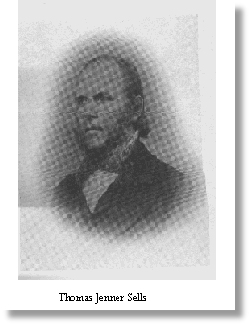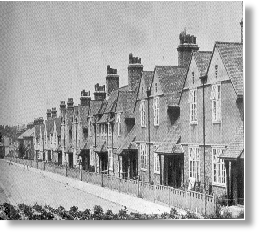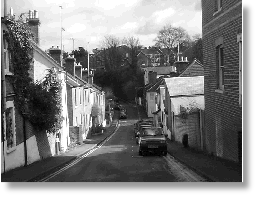
Founded in 1862 Charlotteville was different. It was the brainchild of a local doctor, Thomas Jenner Sells and he named it, rather touchingly, after his wife Charlotte: in honour of his profession he named the major roads after historically important doctors –Jenner, Bright, Addison, Sydenham.
The development was entirely speculative and entrepreneurial, but Charlotteville was fortunate in that not only did Sells have a strong social conscience but his architect, Henry Peak, shared similar views. Peak was a Liberal and a Nonconformist in an overwhelmingly High Church, Tory town but nevertheless gained the respect of his fellow - citizens sufficiently enough to become Mayor in 1899. Between the two of them entrepreneur and architect created a development considerably in advance of its day - the “urban village”
Energised by its proximity to the town, the village was nevertheless intended to be just that: an identifiable and largely self-sufficient entity. A school was built on Harvey Road, shops and the bakery established in and around Addison Road. There was even a chapel in Addison Road, made out of green corrugated iron and known affectionately as the “Tin Tabernacle” which survived until the Sixties. Surprisingly for the period there were no fewer than four pubs all of which have survived at a time when more and more pubs are being turned into shops.
Charlotteville was planned to have a social mix. The large villas on Jenner and Harvey Roads were sold outright for around £5,000 a piece while the cottages on the side roads were rented at between 5/- and 8/- per week. The core of the development was Addison Road, a long straight road built on the side of a shallow valley running into the downs. Peak used local materials: flint, brick, Bargate stone and the terra cotta which is very much a popular building material in Surrey. Some of the front gardens in Addison and Harvey Roads still have garden walls made out of curved terra cotta tiles. Addison Road alone has more than a dozen different architectural styles, lending variety, but it is a token of Peak’s skill that he brought them together to make a homogenous townscape.

Guildford's First Suburb is Born
Brainchild of Local Doctor
A couple of years ago a young BT engineer came to my house to do mysterious things to the telephone. We got talking. It turned out that he was born in Charlotteville, though no longer living here. Not only that, but his parents were born here. Not only that - but both sets of his grandparents lived here. One kept the pub, the other the bakery (The baker’s oven is still there in the basement of one of the houses in Addison Road.
Charlotteville is an excellent case in point.
I liked the story because it gave a lie to the usual glib nonsense about Guildford being a commuter town in the stockbroker belt where people sit around waiting for their house to increase in value before moving on. There is a floating population in the town - the number of estate agents make that clear - but the social core of the town goes back a long, long way.
So what is it? Charlotteville is not simply Guildford’s first suburb, but one of the earliest planned suburbs in Britain. Of course there were suburbs in plenty as the towns and cities expanded in the 19th century. Mostly they were long, long dreary streets of identical buildings where people were housed like battery hens.

Cline Road was to become the centre of the Jubilee Celebrations of 2002
Socially, the development was a resounding success with institutions like a charity, the Cork Club and a cycling club which achieved national reputation. (It is still in existence though no longer based here). The hungry Thirties saw a development of the allotments on the downs which further drew the community together – the local pub, the Forester’s Arms, was unofficially known as the Pig and Tater derived from the products of the allotments. Charlotteville remained physically intact until the late Sixties when, in an act of municipal vandalism dozens of the pretty – and much-needed – cottages on Sydenham Road and Bright Hill were demolished to make way for - a “temporary” carpark. At the same time there was heavy pressure to turn the villas on Harvey and Jenner Roads into commercial use. Holy Trinity Amenity Group was in the forefront of the struggle to prevent this creeping paralysis. The struggle was successful, as a result of which commercial use today extends only about a third of the way up Jenner Road.

A view down Cooper Road as it is today
The recent official designation of the heart of Charlotteville as a conservation area means that most of Peak’s work will survive but what about the social side? There are grounds for a cautious optimism.. By good fortune two modern schools have been established in the village and though they obviously draw on a much wider catchment area it means that local children can walk to school. The very last of the shops sadly closed in November, victim of car parking and the supermarket, and hopes that a large shop and community centre would be established on the St Luke’s development have been dashed. But this large development has been, on the whole, an excellent example of town planning where a large modern estate has been shoehorned into a mature suburb. It is a particularly encouraging sign that the proposals to celebrate the Queen’s Jubilee have been enthusiastically supported by Charlotteville people. Just 140 years after the village was founded it continues to flourish as a community.



